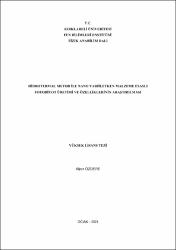Hidrotermal Metod ile Nano Yarıiletken Malzeme Esaslı Fotodiyot Üretimi ve Özelliklerinin Araştırılması

View/
Access
info:eu-repo/semantics/openAccesshttp://creativecommons.org/licenses/by-nc-nd/3.0/us/Date
2021-03-19Metadata
Show full item recordCitation
Özdere, A. (2021). "Hidrotermal Metod ile Nano Yarıiletken Malzeme Esaslı Fotodiyot Üretimi ve Özelliklerinin Araştırılması", Yüksek Lisans Tezi: Kırklareli Üniversitesi Fen Bilimleri Enstitüsü.Abstract
Bu tez çalışmasında Cu2FeSnS4 nanomalzemesi, fotodiyotların üretiminde kullanılmak üzere hidrotermal yöntemi ile sentezlenmiştir. Numunelerin yapısal özellikleri SEM ve EDS teknikleri kullanılarak analiz edilmiştir. İncelemeler sonucunda nanoparçacıkların granüle yapıda olduğu görülmüştür. Elde edilen verilerden Enerji bant aralığı 1.22 eV olarak hesaplanmıştır. Al/p-Si/Cu2FeSnS4/Al diyotunun elektriksel özelliklerinin incelenmesi amacıyla, Akım- Voltaj (I-V), Kapasitans- Voltaj (C-V) ve Akım-Zaman (I-t) ölçümleri farklı ışık şiddetleri altındaki aydınlatmalarda yapıldı ve numunelerin doğrultucu özellik gösterdiği belirlendi. İdealite faktörleri, bariyer yüksekliği, doyum akımı ve foto tepki değerleri I - V ve I - t grafikleri kullanılarak hesaplanmıştır. Elde edilen sonuçlar hazırlanan fotodiyotların optoelektronik uygulamalarda kullanılabileceğini göstermektedir. In this thesis, Cu2FeSnS4 nanomaterial was synthesized by hydrothermal method which was then used used in the production of photodiodes. The structural properties of the samples were analyzed using SEM and EDS techniques. As a result of the investigations, it was seen that the nanoparticles were in a granular structure. Energy band gap is calculated as 1.22 eV regarding the UV-vis data. To assess the electrical properties of the Al/p-Si/Cu2FeSnS4/Al diodes Current – Voltage (I-V), Capacitance – Voltage (C-V), Current – Time (I-t) measurements were performed in different illumination intensities. It was also seen that samples show corrective properties. The photosensitivity and photoreaction properties of the diodes were analyzed. Ideality factors, barrier height, saturation current and photoreaction values were calculated using I - V and I - t graphs. The results showed that the our photodiodes can be used in optoelectronic applications.
Collections
- Tez Koleksiyonu [88]
The following license files are associated with this item:



















